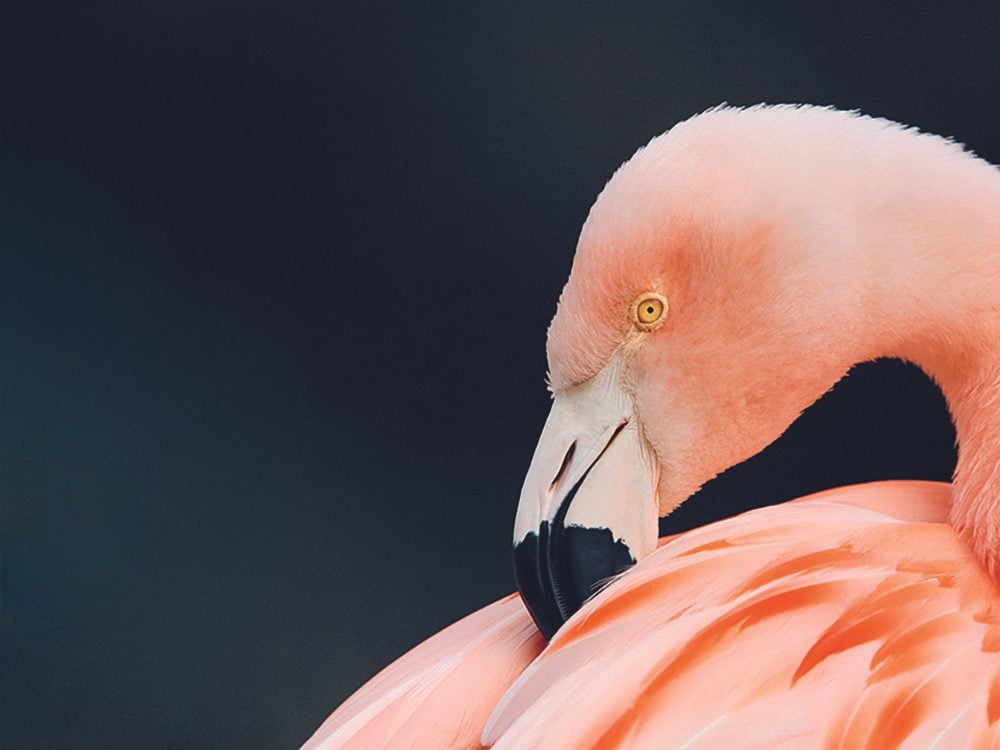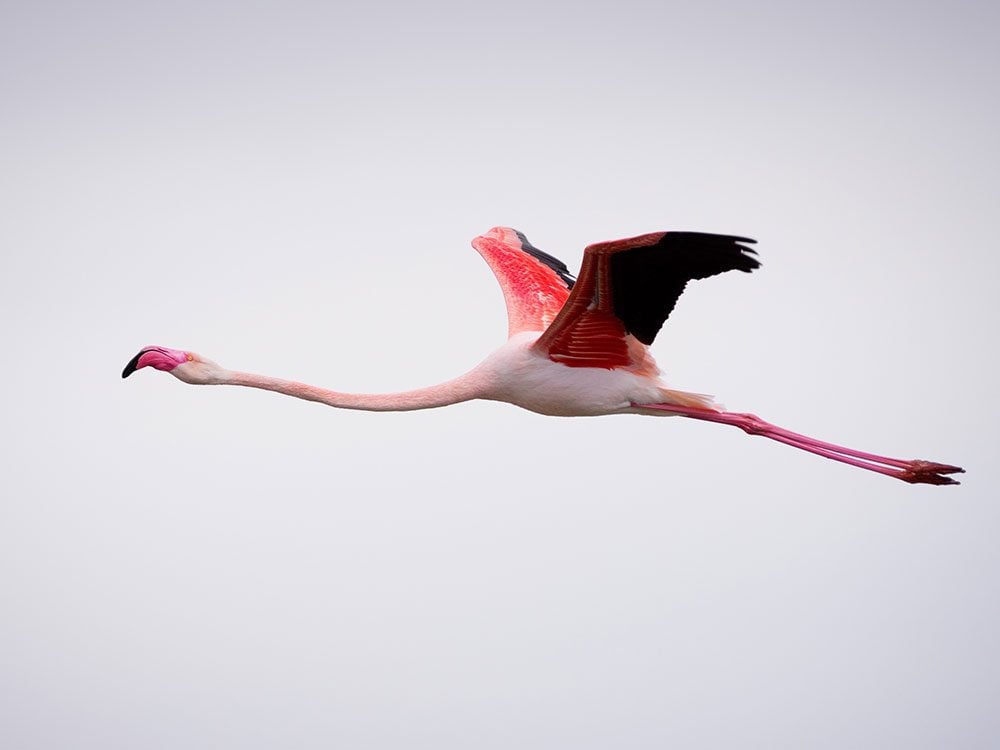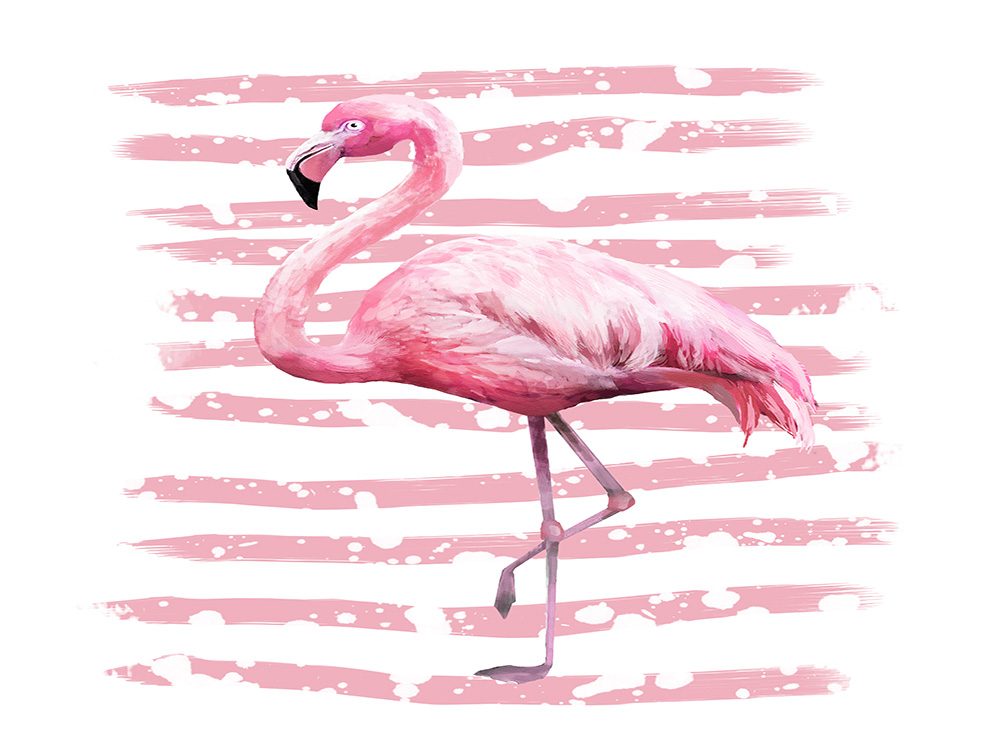
“It’s big. It’s pink. It’s a freaking flamingo!”
Flying free for the first time in her life, the 20-year-old Chilean flamingo soared alone over the foothills and rivers of Connecticut. After a lifetime of domesticated inactivity, her breast muscles ached, yet the lost bird forced herself onward.
It was October 1997. Although the flamingo had never migrated before, instinct told her to head for a warmer climate. But she was of a Chilean breed, so while flocks of migratory North American birds flew south, she flew northwest toward what she thought would be the coast. It was the way to a cold death.
Passing over the Appalachian Mountains, the exhausted bird crossed into Canada. Finally, one day in early November, the flamingo saw a gaggle of Canada geese along an inlet of the Ottawa River and prepared to land among them.
Kathy Nihei, the 53-year-old founder of the Ottawa Valley Wild Bird Care Centre, put down the dropper she was using to feed an injured bird and picked up the ringing phone. The caller was Elizabeth Le Geyt, birdwatching columnist at the Ottawa Citizen, and the story she had to tell made Nihei laugh. “Seriously, Elizabeth? A flamingo? Up here?” she said. “We’ll check it out.”
“There’s no way it’s a flamingo,” said Nihei’s colleague Steve Hamlyn. “It’s probably a heron or a snow goose.” Nihei was dining at her parents’ home that night, November 9, so Hamlyn and a volunteer offered to drive over to Shirleys Bay, where the mysterious visitor had been spotted.
When they got there, they found a pink plumed bird with long, stick-thin legs wading through the shallow waters. Hamlyn phoned Nihei. “It’s big. It’s pink. It’s a freaking flamingo!” he exclaimed.
The following morning Nihei, Hamlyn and several volunteers grabbed some nets, borrowed two canoes and paddled their way out onto the bay. It wasn’t long before Nihei spotted the bird’s radiant body standing out clearly against the cloudy, grey day.
“Aren’t you a strange sight,” she said quietly.

Ottawa, Meet Elisha the Flamingo
They paddled slowly to within five metres of the flamingo. Suddenly the bird raised her broad wings, began a running ascent off the water and landed on a small island. It occurred to Nihei that this rescue might be harder than she’d imagined.
The next morning, Nihei began a blitz of emails and calls to zoos across North America, as well as seabird sanctuaries and anyone with a bit of flamingo experience.
Acting on the information she had gathered, Nihei ordered some flamingo food (the birds eat algae and aquatic invertebrates), obtained some plastic lawn flamingos and a recording of flamingo sounds.
A local birdwatcher posted a message online asking anyone who had lost a flamingo to contact the Ottawa Valley Wild Bird Care Centre.
Then the Ottawa Citizen ran a front-page story about the foreign visitor.
Nineteen-year-old Said Sheikh, a part-time volunteer at Nihei’s centre, had grown up admiring wild flamingos in his native Kenya and years before had rescued a sick one from the Indian Ocean. When he read about the lost bird, he headed out to Shirleys Bay to join the growing number of volunteers.
Among them was Alan Walsh, the devoted father of two young daughters, Shannon, six, and Lauren, nine, who had pleaded with him to “save the flamingo.”
At the bird centre it was a waiting game. During the flamingo’s first week in the Ottawa area, a response to Nihei’s Internet query came in. The bird was an escapee from the Livingston Ripley Wildfowl Sanctuary in Litchfield, Connecticut. Her name was Eilish. To Canadians, however, she soon became known as Elisha.
For the first several days, Elisha played the tourist. One day she’d be seen with the geese at Shirleys Bay; the next she would appear 10 kilometres up- or downriver. By the end of the week, sightings suddenly stopped.
The Canada geese had gone south, and Nihei hoped the flamingo was following them. But experts told her it was unlikely. The geese would soon outpace the flamingo. Left behind, Elisha would probably continue on her own migration—northwest.
During the night of November 16, the flamingo landed once again in the shallow waters of the Ottawa River and went to sleep. Before dawn, the temperature had dropped to -10 C and the water froze around her. When she awoke, her legs were held in an icy grip.
Cub Scouts on a hike spotted Elisha and called Nihei, who immediately gathered her rescue team.
The flamingo watched closely as the humans edged closer to her in a canoe, breaking through slush and ice. When they got within five metres, she began flapping her wings. The ice holding her broke and she flew off awkwardly with frozen chunks caked to her lower legs.
Defeated for the moment, the would-be rescuers paddled back to shore. “We need to come up with a different plan,” Nihei said.

One Smart Bird
Walsh agreed. Over two days he built a trap, five metres in diameter, that could be sprung closed by hand when the flamingo stepped into it.
Back at Shirleys Bay, Nihei baited the trap with food and plastic flamingos. Elisha ignored the lure. “This is one smart bird,” Nihei conceded to Hamlyn and Walsh as they sipped coffee from a thermos in their camouflaged spot.
The next day a volunteer spotted Elisha while feeding ducks at Andrew Haydon Park, along the Ottawa River. The Walsh trap was set up again. To lure the bird in, mirrors were mounted on the shore to reflect her own image, a remote-controlled plastic Canada goose was placed nearby and a tape of flamingo calls played. It didn’t work.
Another rescue attempt was equally imaginative. Hidden behind nets, volunteers artistically camouflaged a canoe with branches and bulrushes, then pushed the watercraft toward Elisha. Not quite asleep, the flamingo kept a wary eye on the floating object. When the strange contraption came to within five metres, she flew off to a more tranquil spot.
On November 21, the bay froze over completely. Two days later, the flamingo was spotted feeding at the mouth of a creek 10 kilometres upriver.
Sheikh donned a pair of chest waders to protect himself from the freezing water and tucked an extendable butterfly net in the back. He moved toward the flamingo on his knees. As he had done in his Indian Ocean rescue, he rubbed his fingers together underwater, imitating the sound of another flamingo feeding. The bird began walking toward him.
“I don’t believe it. She’s going to walk right into Said’s arms!” Nihei whispered to Hamlyn. Elisah was almost within Sheikh’s grasp when he slipped into a hole on the river’s floor and made a splash. The flamingo flew off.
By December the flamingo was spending most of her time feeding at the mouth of the creek, occasionally walking into a narrower section that was seven metres wide. Nihei hoped that a special trap at this spot would succeed. To make the trap, they needed seven large and nearly invisible nets—but the cost was far higher than the bird centre could afford.
By now, however, Elisha’s desperate situation had touched people’s hearts. Three nets were donated when an appeal went out. Four more were needed. Then a call was received: the Ottawa Citizen would donate the rest.
The nets arrived on December 5, and Nihei, Hamlyn and 10 volunteers spent six hours building a trap across the creek. They drove poles into the ground on either side and stretched the netting over three sides and across the top, leaving a length over the front to act as a door. On either side of the trapdoor they built blinds of straw and leaves.
Working in pairs, the volunteers began a round-the-clock vigil. Days passed, but not once did the bird enter the trap.
Then a cold snap hit and ice formed over the creek. The flamingo disappeared, and many thought she had succumbed to the elements.
Check out 8 of the World’s Strangest Birds!

“There she is!”
On December 10, with still no sign of her, the rescuers decided to take the trap down. It was time to admit failure. Nihei was putting on waders to get into the river and free the trap from the ice when a cry went out: “There she is!”
The flamingo stood just 20 metres away. Nihei was so excited she rushed to break the ice in the trap with her bare hands. Aided by Hamlyn and Walsh, she cleared the trap and the trio regained their hiding places.
Come on bird, let your stomach get the better of you, Hamlyn thought as the hungry flamingo pecked at the ice, desperate to get at food. Then Elisha heard the faint bubbling of running water coming from the trap. She stepped into the netted area, submerged her head in the water and began to feed.
Walsh put his hand in the air and as the bird turned toward the back of the trap, threw his arm down. “Now!” he signalled. Hamlyn rushed into the net, grabbed the flamingo and clutched her to his body. She didn’t struggle. With a huge grin, Hamlyn kissed the top of her ruffled head.
When pictures of a safe Elisha graced the front pages of Ottawa newspapers the next day, it seemed the whole city let out a sigh of relief.
No one was happier to hear the news than renowned ornithologist S. Dillon Ripley, founder of the sanctuary in Litchfield, home to 80 species of birds from around the world. When workers had approached Elisha to clip her growing flight feathers, she had flown away. They had tried unsuccessfully to rescue her in Connecticut for about a month after her escape, but then she’d disappeared and was presumed dead.
Within a week at the Ottawa Valley Wild Bird Care Centre, Elisha had returned to her normal weight. Courtesy of Air Canada, she was shipped back home to Litchfield, where she rejoined her mate and her flock.
(For another harrowing Canadian rescue story, check out What Would Noah Do?: How the Calgary Zoo Saved 200 Animals From the Flood.)